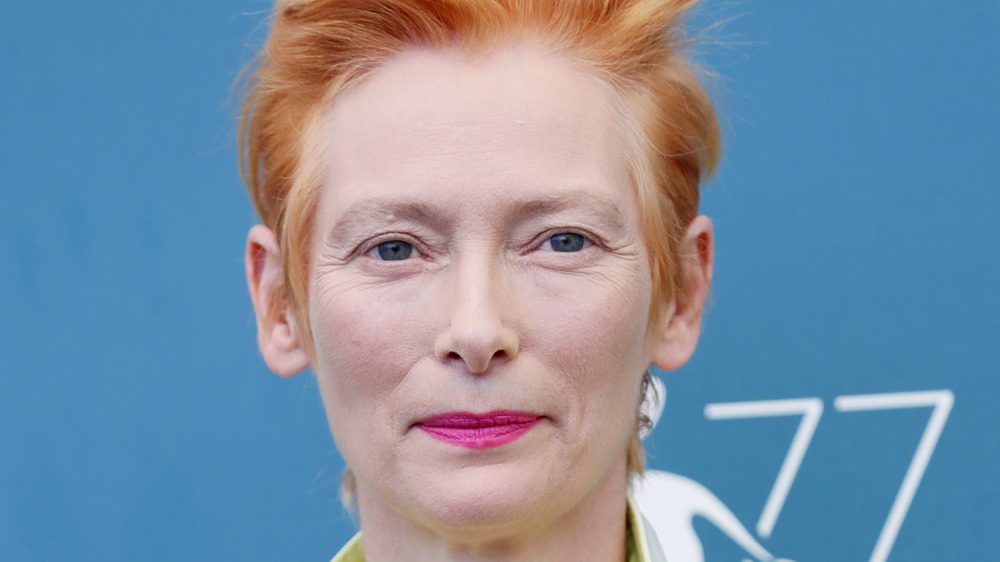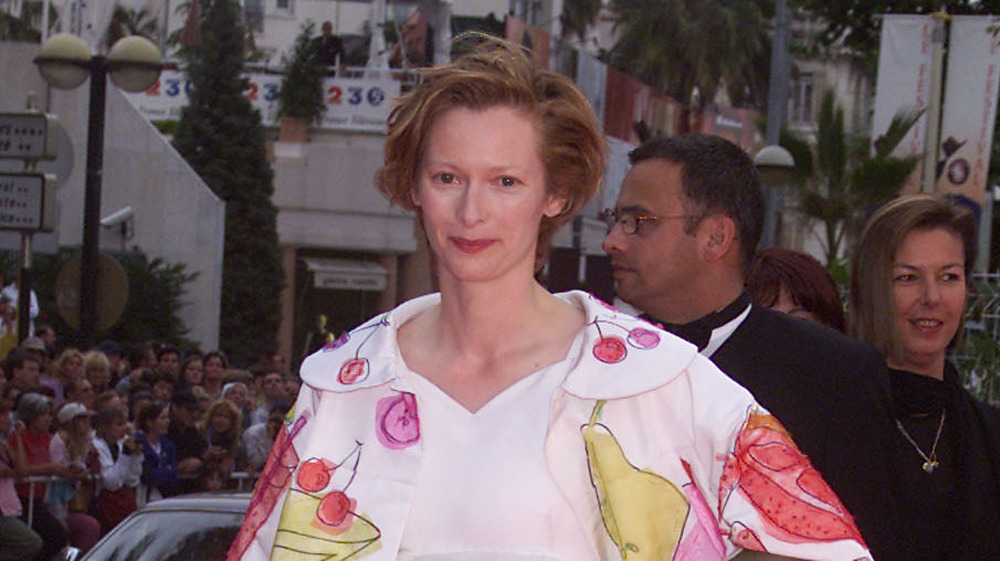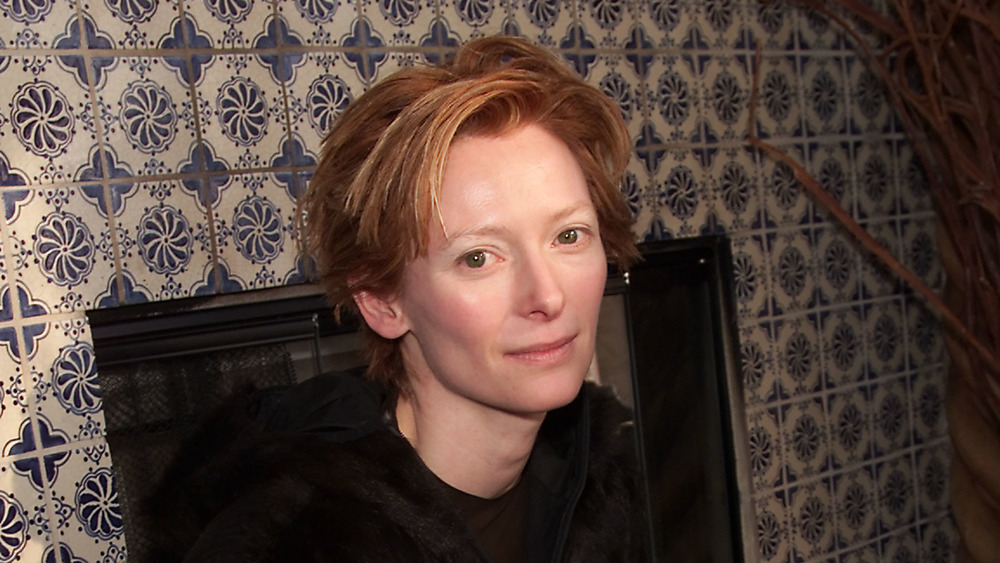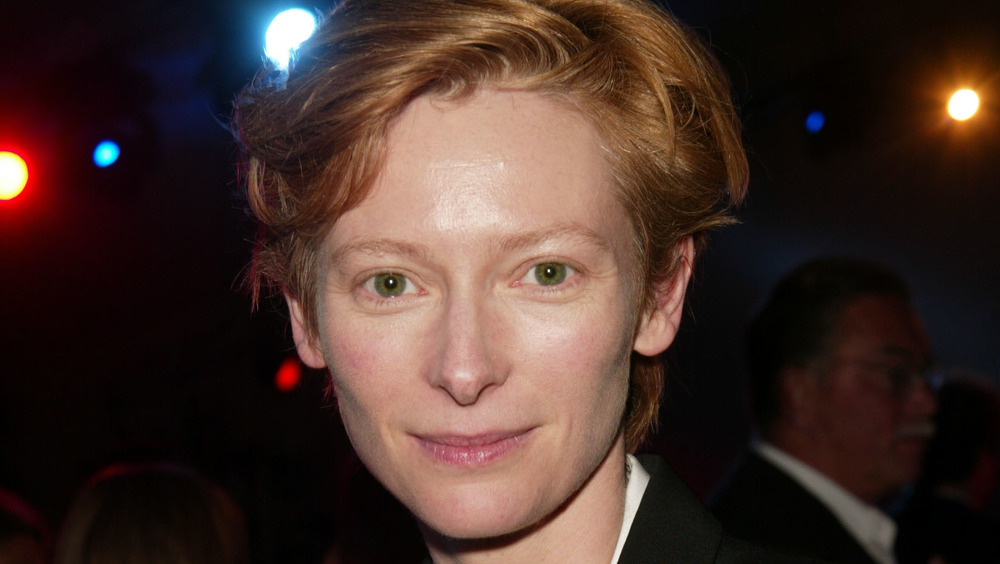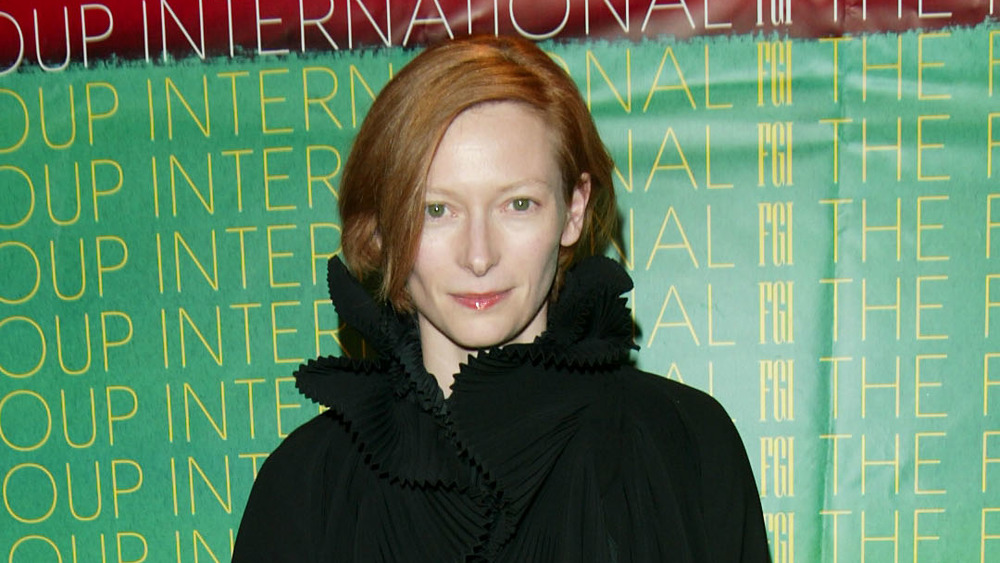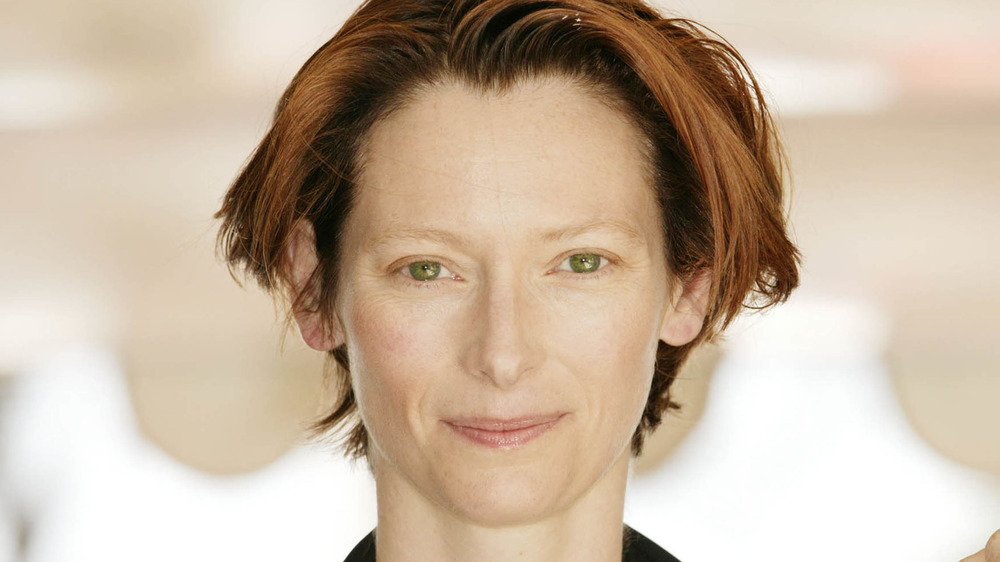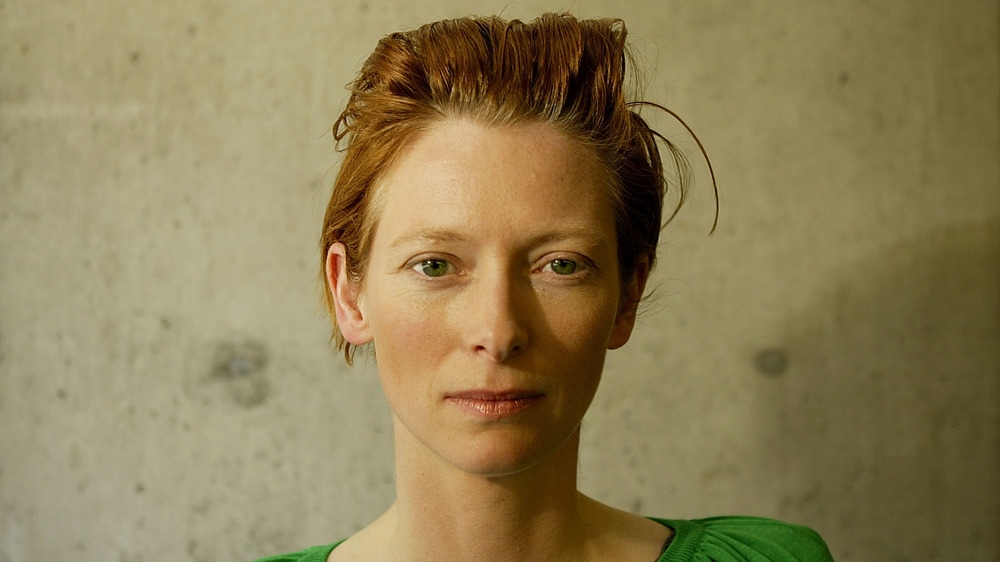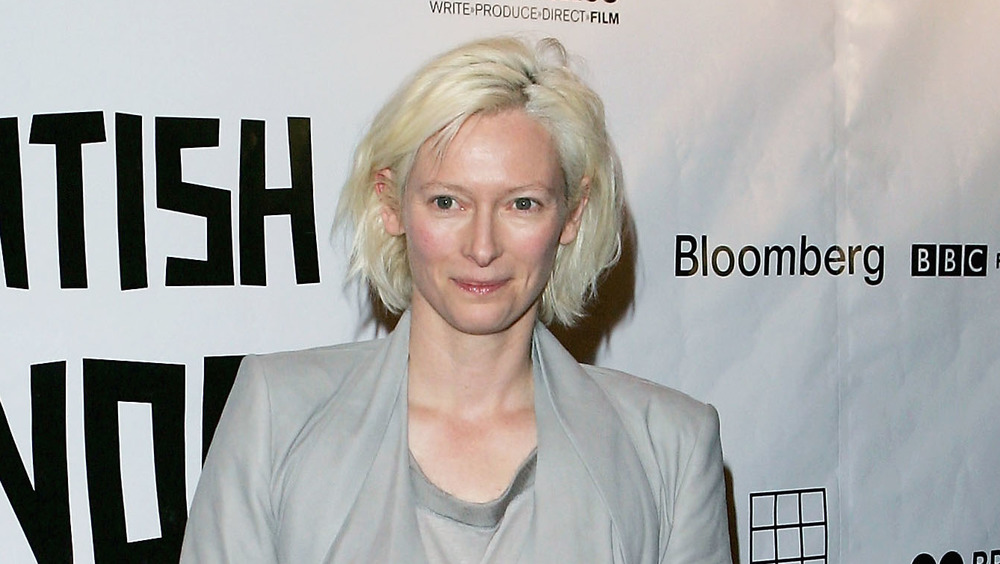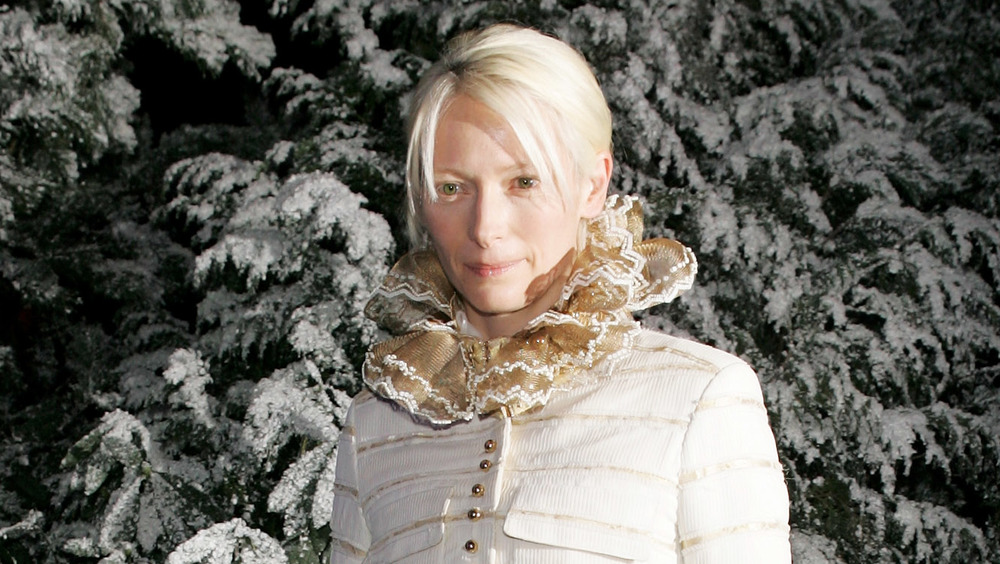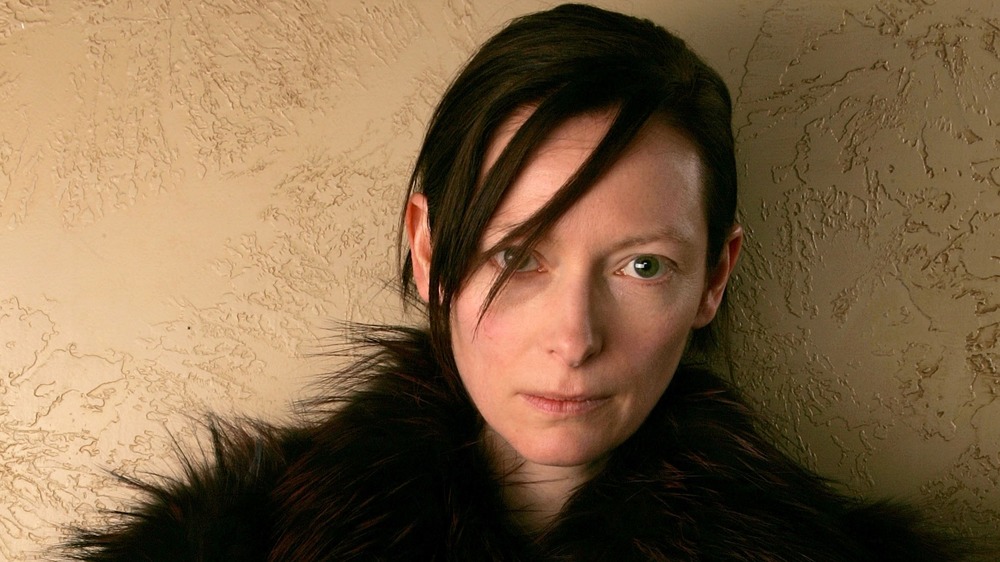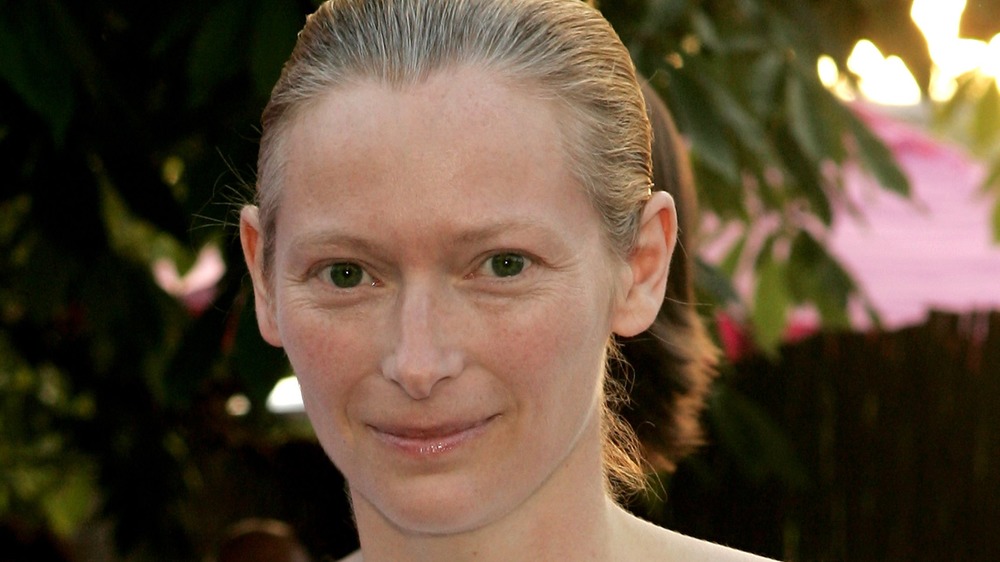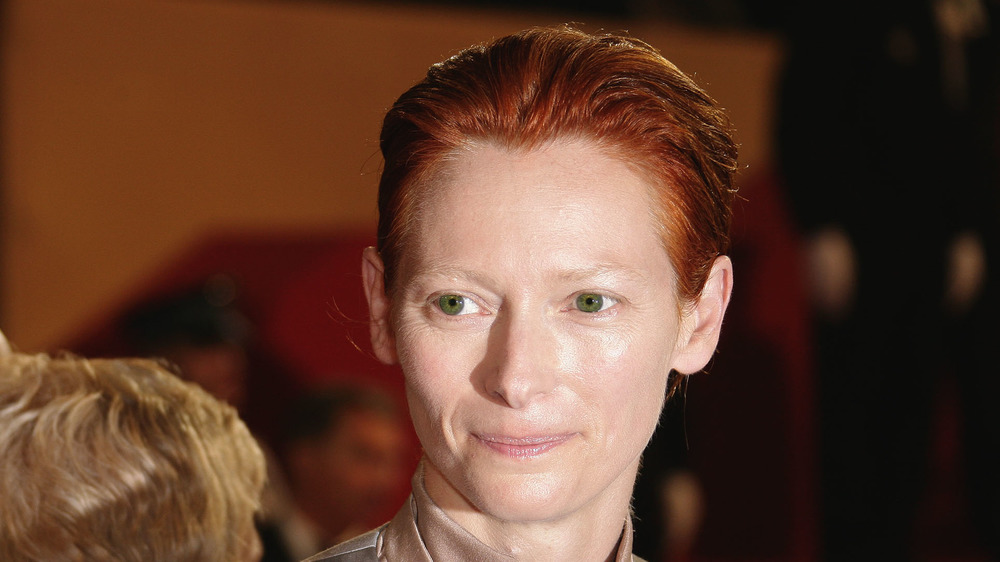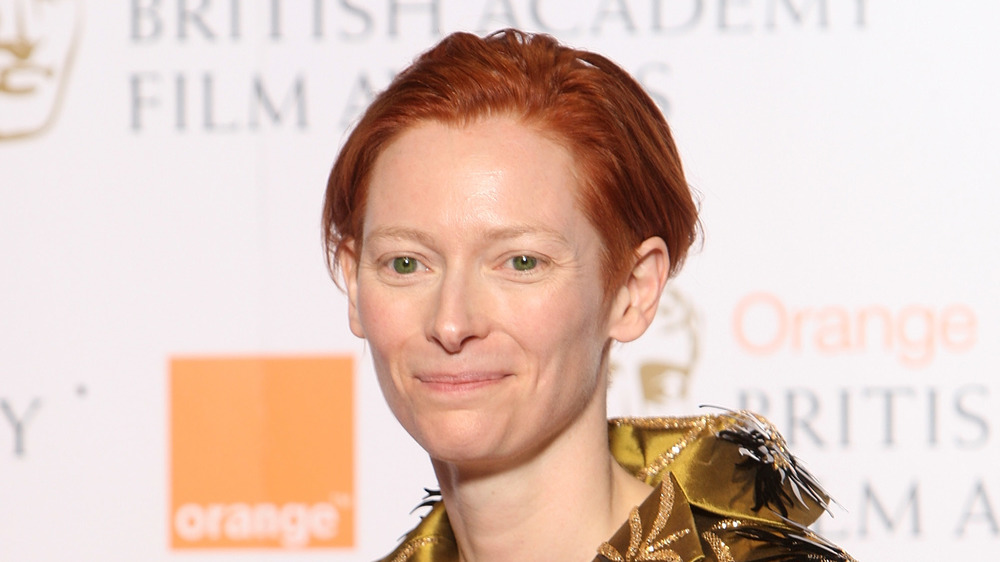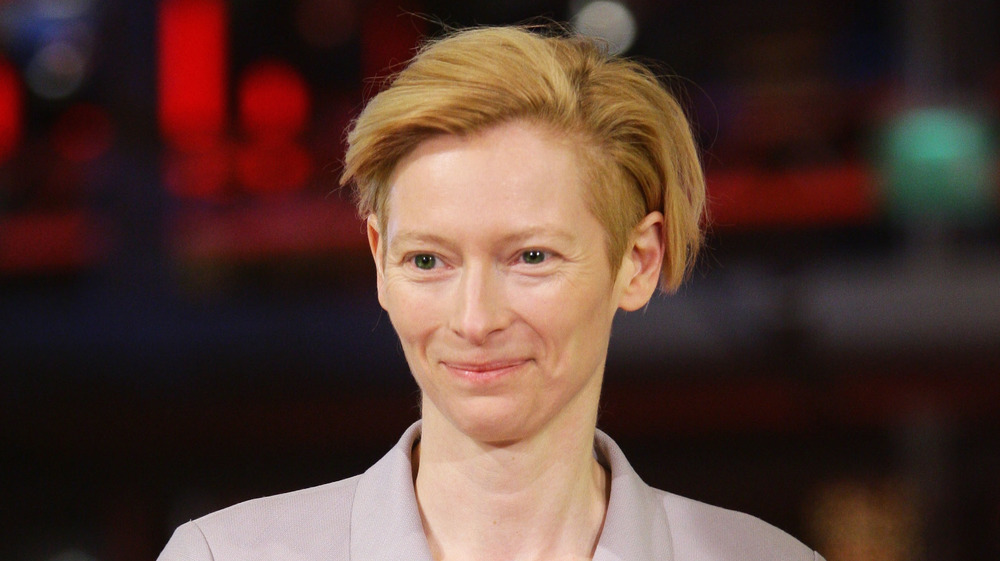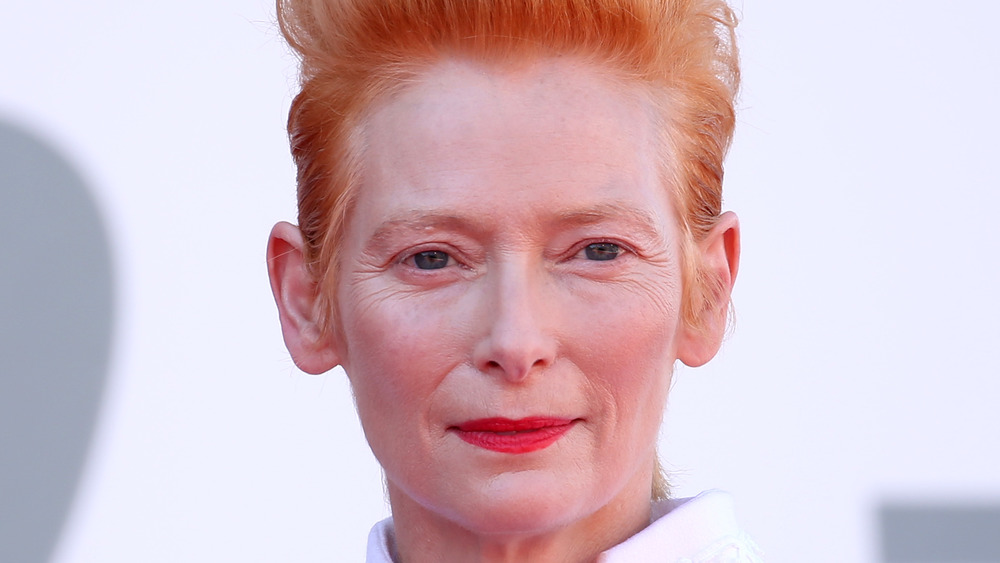The Stunning Transformation Of Tilda Swinton
Tilda Swinton is probably one of the world's best-respected and most sought-after actresses. Her extensive, impressive career has spanned four decades and has featured turns in art-house films like Caravaggio alongside more mainstream appearances in films like Orlando, We Need to Talk About Kevin, and even The Chronicles of Narnia: The Lion, the Witch and the Wardrobe (via IMDb). She has worked on a diverse range of films with some of the top directors in cinema, including Wes Anderson, Derek Jarman, Jim Jarmusch, and the Cohen brothers. As Numero mused, aside from a few French actresses, "It's hard to think of anyone who could rival her in terms of diversity and creative energy."
Her strikingly androgynous look alongside her whip smart conversation has given Swinton a reputation for being something of an otherworldly enigma in Hollywood. In fact, she frequently corrects members of the press who refer to her as an actress. As she told Variety, "When I hear proper actors talking about their lives and how they approach their work, I feel like I'm up another tree."
So, how did this non-actress get to the top of the acting profession? Here is the stunning transformation of Tilda Swinton.
Tilda Swinton was born into a wealthy family, in which she felt out of place
Despite being one of the best-known actors of her generation, Tilda Swinton doesn't consider herself a real actor. It turns out, feeling out of place is nothing new for Swinton. As she explained to Vogue, her privileged, buttoned-up upbringing wasn't particularly artistic, which always made her feel like a fish out of water. "I grew up in a family where I felt like a changeling," she said. By the sounds of things, Swinton's family weren't particularly interested in art. Instead, they were focused on status.
Her father, Major-General Sir John Swinton, was from a well-known Scottish family, as The Guardian noted. He was once the "head of the Queen's household division and lord lieutenant of Berwickshire." For Swinton, growing up in such a well-to-do family gave her her signature posh accent, but it also gave her a lifelong rebellious streak.
Tilda Swinton has always felt like an old soul
Tilda Swinton has always seemed notably wise for her years. When she was 55, she explained to Junkee, she couldn't really remember feeling young. "I not only feel really old, but have always felt really old." She went on to explain that the older people in her life had a huge influence on her, including "[her] grandmother who lived until she was 98." Emulating the elders in her life taught Swinton the calming power of perspective. "You just keep breathing, you look forward, and you know it shall all pass," she said.
This feeling of being an old soul led to some very early experiences of philosophical and political thought for Swinton. As she told the Express, her strict upbringing taught her to rebel against her family's conservative values. As she explained, she was just 5 years old when she began to question the archaic British class system, noticing that her lower-class friends had to sit in a different section of the church every Sunday. Since then, Swinton has been firmly Left-wing.
Tilda Swinton struggled at her all-girls' boarding school
Being a member of the British upper class meant that Tilda Swinton was sent off to boarding school at the young age of 10. As Swinton explained to The Guardian, she was just beginning to develop her sense of self at the time. "So it's a weird moment to go, 'OK, we're going to distract you from all that useful evolutionary work, and lump you together with a lot of people on a desert island called school and leave you to it," she said.
At first, the prospect of the all-girls' boarding school gave Swinton a chance to embrace her femininity, having been raised in a predominantly masculine household. However, she soon realized that boarding school was not a good fit for her. Swinton was homesick and badly bullied and practically stopped speaking for five years. She also felt that the school's main purpose was to prepare her and the other girls for good marriages. "It was a holding bay," she recalled.
In the end, the experience taught Swinton exactly what she didn't want from life. As she put it, "We managed to survive."
Tilda Swinton studied writing at Cambridge University, but realized it wasn't for her
After her unhappy boarding school years, Tilda Swinton finally had a little more freedom to pursue a more independent life. Initially, she planned on becoming a poet. She set off for Cambridge University to study writing, but almost as soon as she arrived, she gave up on her dream of becoming a writer. "I got into Cambridge as a writer, and I stopped when I got there," she told Vogue. "It was terrible. I'm still kind of [traumatized] by it."
Giving up writing was clearly painful for Swinton. As she told The Guardian, she fell out of love with it because of her classes. "It's got something to do with a very early snow blindness about how I was asked to read and how I was asked to write, and it totally froze me up," she recalled.
Though she gave up writing, she quickly found a new interest — acting. She began to perform in student theater, but remained tentative. As she put it to Variety, "I had a very ambivalent relationship with the theater."
Tilda Swinton's career began in theater, but it didn't feel quite right to her
Even though Tilda Swinton wasn't sure whether she wanted to pursue acting as a career, she ended up working with the Royal Shakespeare Company after leaving Cambridge. As she told The Guardian, theater never became a passion. "I was looking for film, always," she said. "I only worked in the theatre because my friends were working there. I just slid sideways into it, and at a certain point [realized] it was absolutely not what I was interested in."
Again, Swinton found herself feeling out of place. In fact, she disliked her time at the Royal Shakespeare Company so much, she decided she definitely didn't want to be an actor. "It was after a year there," she told Variety, "that I decided I didn't want to be an actor, which was a really good piece of information to have."
Swinton felt a little more at home in more experimental theatrical productions. As she told Vogue, "I worked in experimental theatre, at the Traverse and at the Almeida, which I have great, very fond memories of." Nevertheless, when working in film became an option, she never looked back.
Tilda Swinton's film career began with seven films by Derek Jarman in 1985
Even though Tilda Swinton says she decided not to become an actor after working at the Royal Shakespeare Company (RSC), she soon found herself taking another step on the path toward the life of an actor. She met the director Derek Jarman after leaving the RSC and felt an instant creative connection. As she told Variety, "He met me at a door with a video camera and we started talking, and we never stopped." In 1986, she starred in his film Caravaggio. Over the next eight years, they collaborated on six more films.
These early art-house films were Swinton's first experience of film acting. And, as The Guardian noted, working in these films, for Swinton, didn't feel like acting at all. In fact, as she told Rolling Stone, Jarman's approach to filmmaking showed her that she could be in movies without being a traditional actor. "What Derek opened up to me ... it was just home," she said. "I knew that I wasn't interested in being an industrial actor; I knew I wasn't interested in being an industrial theater-maker. I was always an experimentalist."
Tilda Swinton took part in a performance art piece in 1995
As an experimental woman in film, rather than a traditional actress, Tilda Swinton continued to push boundaries with her work after Derek Jarman's death in 1994. As she told NPR, his death coincided with a dip in funding for art-house films. So, in 1995, Swinton made her first foray into the world of performance art with a piece called "The Maybe." According to AnOther, Jarman's death inspired the piece.
In "The Maybe," Swinton lay in a glass box asleep, or trying to sleep, for eight hours a day. The performance was referred to as a "memento mori," or, as AnOther explained, "a performative monument to fragility, to our mortality and to collective mourning."
In an interview with Art magazine, Swinton said that she came up with the idea for the performance art piece after seeing people lining up to stare at Lenin's corpse (via To Schirn Mag).
Having children was a joyous experience for Tilda Swinton
Tilda Swinton met the playwright and painter John Byrne in the mid-80s when she was still working in theater. In 1990, they became a couple and moved to Scotland. In 1997, she gave birth to twins, Honor and Xavier Swinton Byrne. Unlike many of her colleagues, Swinton raised her children in Scotland and even taught them Gaelic. As she told the Express, "I don't know how people do it without living in Scotland — that's how I think of it."
For Swinton, starting a family was a wonderful step in her life. "I remember noticing, when I had my babies, how much I liked them, and not just loved them, but I was really into them," she told The Guardian.
By the sounds of things, Swinton's children share her sharp, intelligent streak. "They are teaching me, what can I say," she told E. Nina Rothe in 2020. She described them as "pretty clear," saying proudly, "They have a strong sense of perspective."
Tilda Swinton met her partner Sandro Kopp on a movie set and began an open relationship
Tilda Swinton has never been very traditional or conventional. Her family life is no exception. In 2004, while filming The Chronicles of Narnia, Swinton met Sandro Kopp, a German painter who had a non-speaking role as a Centaur in the film. As Kopp told the Evening Standard, they "met at a party during the shoot." In 2005, he moved into Swinton's family home in Scotland, while John Byrne relocated to Edinburgh to be with his new partner. Initially, some media outlets thought Swinton's relationship with the two men meant a ménage a trois, but, as it turns out, things weren't quite as scandalous.
Swinton summed up her unusual family life, explaining to the Express, "What is true is that John and I live here with our children and Sandro is sometimes here with us, and we travel the world together. We are all a family." And in an interview with the Independent, she stated, "We live an extremely orthodox life," sharing that she was not with Byrne anymore. As The Scotsman noted, Swinton and Byrne have clearly remained friendly co-parents who get along incredibly well, even if they're no longer romantically involved.
This is how appearing in The Chronicles of Narnia transformed Tilda Swinton
For Tilda Swinton, meeting Sandro Kopp wasn't the only life-changing thing to come out of filming The Chronicles of Narnia. The film — whose young stars grew up to be gorgeous — proved to be her first major mainstream success. As she told The Scotsman, it was her first real experience of being a "movie star." For Swinton, it was actually a nice change. She said it was "kind of great, to be honest. I'm happy to be a movie star. The downside of being an arthouse freak is that it's a kind of elitist sport. I really like people waving at me in airports."
As Swinton explained to The Irish Times, her appearance in the Disney franchise came about because of the director rather than the production company. "I do these projects because I like the director," she said. "I can assure you it was Andrew Adamson's idea to cast me, not Disney's."
Even though Swinton told The Irish Times she had no "plan to move into the mainstream," Narnia did mark something of a transition. Her later roles – including a role in the Marvel movies – tended to be bigger and grander.
Tilda Swinton won an Oscar for her performance in Michael Clayton in 2007
One of Tilda Swinton's most memorable roles came in 2007 when she played a neurotic lawyer in Michael Clayton. The role earned her her first and only Oscar nomination and win, as of this writing. As Rolling Stone noted, the film was definitely part of her move to big-budget blockbusters — nevertheless, Swinton remained determined to keep her distance from labels like "Hollywood movie star."
In fact, she even refused to think of the movie as a studio picture. "The reason I don't think of it as a studio picture is because it was in New York and because it felt fairly intimately made," she explained. The film also tested her technical skills as an actor. "What was different there was ... the caliber of the narrative and the kinds of performances that it asked for — [was] much finer, much more naturalistic, much less fantastic, much less expressive," she said, adding, "That was a bit of an adventure for me."
Even though the movie earned Swinton an Oscar, she tried not to let it affect her. "I knew that it was a big deal," she explained, "but it didn't have any real impact in my life."
Tilda Swinton's life in Scotland is her refuge
Scotland has become a huge part of Tilda Swinton's life. She always preferred it to the glitz and glamour of Hollywood. In 2001, she moved to the northern Highlands of Scotland, where she currently lives. As Swinton explained to The Scotsman, her life is a busy one, with plenty of globetrotting for work. Returning to her family in Scotland became a refuge. "It's like that scene in Oliver! when he wakes up in the grandfather's house and he looks out of the window and sings, 'Who will buy this wonderful morning?'" she said, describing her idyllic Scottish existence. She added, "When I get to Inverness airport, I get off the plane and I want to kiss the tarmac."
As Swinton told Vogue, her life in the Highlands is a lifelong dream come true. "If you'd asked me when I was 10 or 20, I would have said my only ambitions were to live in a family, to have friends that made me laugh and laughed at my jokes, and to live in the Highlands of Scotland, by the sea ... Seriously." Her career success, she said, was "a bonus."
Tilda Swinton went back to basics creatively during lockdown in 2020
Tilda Swinton spent a lot of 2020 working. However, the lockdown affected her nonetheless. As Swinton explained to Vogue, she found herself craving "a sort of back-to-basics comfort." She elaborated that this meant "going back to my great [favorites] like Michael Powell and Emeric Pressburger, Hitchcock, Carole Lombard." As she went on to explain, she found herself feeling a little creatively stunted, so classic films became her only way to start feeling inspired. "As Slavoj Zizek would say," she mused, "we need the cinema to know what our desires are. I think the pandemic has kicked us into [realizing] how much we need cinema and live music."
For Swinton, the pandemic reminded her of the importance of her own work, while also giving her the chance to rediscover the art she loved when she was younger — not bad discoveries to make!
Tilda Swinton came out officially as queer at the age of 60
Tilda Swinton made quite a stir in 2021 when she described herself as "queer" to Vogue at the age of 60. For Swinton, her queerness is "to do with sensibility." As she explained, she had always identified as queer. "I was just looking for my queer circus," she said, "and I found it. And having found it, it's my world." She explained that her "queer family" consisted of her artistic colleagues like Wes Anderson, Bong Joon-ho, Jim Jarmusch, Luca Guadagnino, Lynne Ramsay, and Joanna Hogg.
While Swinton's revelation came relatively late in life, most fans thought it was "unsurprising," as she's always been known for her androgynous vibe and outlook on life. In fact, in 2009, she explained to The WIP that she had always been interested in "transformative" identity. It's nice to see Swinton openly embracing a queer identity.
